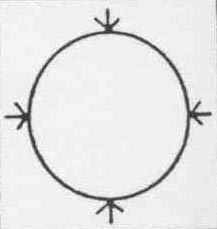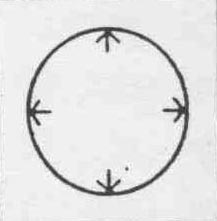9 - Translation loss: cultural factors
|
   |
"She certainly did not tolerate my giving up the other languages; education, for her, was the literature of all the languages she knew, but the language of our love – and what a love it was! – became German"1
In the two previous units, we have examined some implications of time factors as regards translational loss. Let us now examine cultural factors. Every text originates as an expression of some contradiction between the transmitter’s culture and the model reader’s culture. This aspect – evident in every text – is particularly noticeable in interlingual translation, in which the more superficially perceivable linguistic differences are added to the cultural differences.
Consequently, every text is a compromise formation, a mixing of cultural trends.
We indicate such a phenomenon with a semiotic term: “creolization” of two texts, the original’s text and the translation’s text (Popovič 1975: 130).
As much as Creole is a language synthesizing influences of two very different cultures, in semiotics the notion of "creolization" is used in a broad sense, even for cultural influences that not necessarily have to do with language. The two cultures of a translation undergo a recipro cal partial coincidence as in this illustration, taken from Popovič:

Such a source culture (1) is usually in turn a conglomeration of the author’s personal culture and the collective culture of her environment. The receiving culture (2) is instead the culture of the "outer world", the others’ world. Such a semiotic contradiction is the same stressed by Yuri Lotman (1968) when he talks about the Self-Other relation, between We and Them and so on. In interlingual translation, such a contradiction is self-evident because it is the meeting of two cultures, the prototext and the metatext cultures. In Popovič’s opinion, three different situations can be outlined in that explosion of contradictions between cultures.
The first is represented by this figure (Popovič 1975: 131):

Here, activity in the prototext culture (1 in the previous figure) is stronger than the activity of the metatext’s culture (2 in the previous figure). The source culture therefore exerts a centripetal stress on the receiving culture.
A second case is represented by this other figure:

Here, activity in the metatext culture (2 in the previous figure) is stronger than the activity of the prototext’s culture (1 in the previous figure). The source culture therefore exerts a centrifugal stress on the receiving culture.
The third and last case is represented by the following figure:

In translation, a balanced interaction of source culture and receiving culture takes place. Since in a translation only one version is expressed, the translator must solve these contradictions in one of three ways. Each way produces a different kind of loss.
If the translator chooses the first solution, the reader of the translation comes across many elements of the protoculture, and the communication loss mostly consists in the readability of the text (that sometimes preserves the construction traits typical of the source culture) and in the understandability of realia and of other culture-specific elements.
If the translator chooses the second solution, the reader of the translation is dealing with a text that is very readable and fluent, where culture-specific elements were substituted by elements that are culture-specific in the reader’s culture: in this case, the communication loss consists mainly in the lack of transposition of the text’s culture-specific elements, a text that has lost its cultural identity for the benefit of readability.
If the translator chooses the third solution, the translation loss will be mixed: it will consists in part of culture-specific elements, and in part of linguistic and construction elements. Popovič expresses the dialectics between the two poles in this way:
Let us consider the translation situation where an other culture’s confines are completely erased, when in translation the impression of "translated" is lost, so is the pole representing the Self. By contrast, let us consider a situation in which the receivers find themselves in the framework of the other culture, not considering their predisposition and their conditions for its reception, [this is] the extreme stressing of the cultural pole of the original in a translation (Popovič 1975: 138-139).
The reason why Popovič dwells so much on the notion of “creolization” is that the totality of the actualizations of a prototext is located along the continuum between these two poles, while the case could hardly real ly exist of a version embodying the appropriating remake in absolute terms or the unreadable acknowledgement. Once the existence of these two poles is acknowledged, therefore, in such a view one has to examine every single real translation actually realized as a creolization along the axis between the two poles.
In this perspective, translation loss is always to be located in terms of cultural distance of the reader from the text, or cultural distance of the text from the original.
Bibliographical references
CANETTI ELIAS Die gerettete Zunge. - Die Fackel im Ohr. - Das Augenspiel, München, Carl Hanser Verlag, 1995, ISBN 3-446-18062-1.
CANETTI ELIAS The Tongue Set Free. Remembrance of a European Childhood, translated by Joachim Neugroschel, in The Memoirs of Elias Canetti, New York, Farrar, Straus and Giroux, 1999, ISBN 0-374-19950-7, p. 1-286.
LOTMAN JU. O metajazyke tipologicheskih opisanij kul´tury [On the metalanguage of typological descriptions of culture], 1968, in Semiosfera, Sankt-Peterburg, Iskusstvo-SPB, 2000, ISBN 5-210-01488-6, p. 462-484.
POPOVIČ A. Teória umeleckého prekladu, Tatran, 1975. Russian translation by I. A. Bernshtejn and I. S. Chernjavskaja, edited by N. A. Kondrashov, Problemy hudozhestvennogo perevoda, Moskvà, Vysshaja shkola, 1980.
1 Canetti 1999: 77.
|
|
|
   |
|

